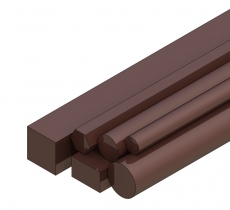
Heat Balancing
Questions and Answers
Pressure is one of the three major inputs of the machine, pressure, current and time. Pressure is called out as force in weld schedules. Force per square inch is pressure. When pressure is applied and the electrode makes contact with the part, there is a contact resistance at that joint. The amount of this resistance changes with the amount of force/pressure being applied.
Class 3 material is a designation of the Resistance Welding Manufacturers Alliance (RWMA). It describes a group of copper alloys with excellent strength and good electrical conductivity. Class 3 is often used to weld stainless steel, nickel alloys and other highly resistive - strong materials that require high weld forces.

Class 3 Bar Stock
Class 2 material is a designation of the Resistance Welding Manufacturers Alliance (RWMA). This is a group of copper alloys with high strength and electrical conductivity. Class 2 is the most used material in the resistance welding industry. As electrodes it is used for welding bare and coated steels.

Class 2 Bar Stock
Class 1 material is a designation of the Resistance Welding Manufacturers Alliance (RWMA) which describes a group of copper alloys with good strength and high electrical conductivity. Class 1 is often used to weld aluminum and other good conductors like brasses and bronzes which require high weld currents.

Class 1 Bar Stock
Heat balancing is adjusting heat input so that the nugget forms at the center or more importantly the faying surface. Resistance welding two different work piece materials will often cause the heat to build up in one before the other. The same is true if the thicknesses are unequal. This frequently leads to the nugget forming mostly in the hottest side of the part instead of at the faying surface.
Page 1 of 2
Have a Question?
Do you have a question that is not covered in our knowledgebase? Do you have questions regarding the above article? Click here to ask the professor.
